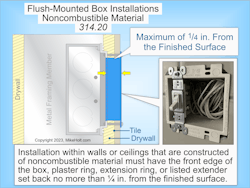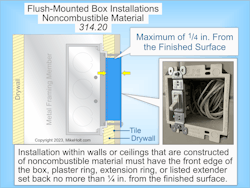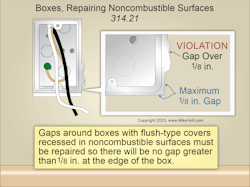Courtesy of www.MikeHolt.com
All questions and answers are based on the 2023 NEC.
Q. What are the NEC requirements related to flush-mounted boxes?
A. The NEC requirements related to flush-mounted boxes can be found in Sec. 314.20.
Noncombustible Walls and Ceilings. Installation within walls or ceilings finished with a noncombustible material must have the front edge of the box, plaster ring, extension ring, or listed extender set back no more than ¼ in. from the finished surface (Fig. 1).Combustible Walls and Ceilings. Installation within walls or ceilings constructed of wood or other combustible material must have the front edge of the box, plaster ring, extension ring, or listed extender extend to, or project out from, the finished surface.
Author’s Comment:
- Plaster rings and extension rings are available in a variety of depths to meet the above requirements.
- Final finished surfaces (such as backsplashes and tile) may need the use of listed extenders to meet the requirements of this section.
Q. What are the NEC requirements when boxes are installed in noncombustible surfaces?
A. The NEC requirements for this installation are found in Sec. 314.21.
Gaps around boxes that are recessed in noncombustible surfaces (such as plaster, drywall, or plasterboard) must be repaired so there will be no gap greater than 1⁄8 in. at the edge of the box (Fig. 2).Author’s Comment: Other examples of noncombustible surfaces include ceramic wall tile, ceramic or marble floor tile, brick, cinder block, and other types of masonry or stone. All these examples are subject to the requirements of Sec. 314.20 and Sec. 314.21.
These materials are provided by Mike Holt Enterprises in Leesburg, Fla. To view Code training materials offered by this company, visit www.mikeholt.com/code.
About the Author

Mike Holt
Mike Holt is the owner of Mike Holt Enterprises (www.MikeHolt.com), one of the largest electrical publishers in the United States. He earned a master's degree in the Business Administration Program (MBA) from the University of Miami. He earned his reputation as a National Electrical Code (NEC) expert by working his way up through the electrical trade. Formally a construction editor for two different trade publications, Mike started his career as an apprentice electrician and eventually became a master electrician, an electrical inspector, a contractor, and an educator. Mike has taught more than 1,000 classes on 30 different electrical-related subjects — ranging from alarm installations to exam preparation and voltage drop calculations. He continues to produce seminars, videos, books, and online training for the trade as well as contribute monthly Code content to EC&M magazine.



